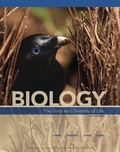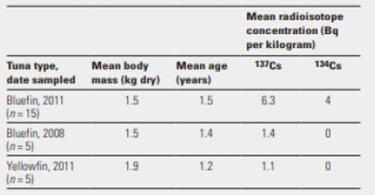
Bioaccumlation in tuna Bluefin tuna are among the fishes that were exposed to radioactive material released into the sea by the damaged Fukushima nuclear power plant (Section 47.1). These tuna breed in the western Pacific, and some migrate to the Eastern Pacific when they are 1 to 2 years old. Daniel Madigan suspected that migrating tuna would transport radioactive material to the waters off the coast of California. To test this hypothesis, he and his collaborators analyzed the concentration of cesium radioisotopes (137Cs and 134Cs) in bluefin tuna and yellowfin tuna caught near San Diego in August 2011. Yellowfin tuna do not cross the Pacific; they spend their lives in California's coastal waters. The scientists compared these data with the radioisotope content of bluefin tuna that had been caught near San Diego in 2008. FIGURE 48.9 shows their results.

FIGURE 48.9 Radioactive cesium (Cs) concentration in two species of tuna caught along the coast of California.
137Cs has a half-life of 30 years and some persists in the Pacific from weapons testing. 134Cs has a half-life of 2 years and was undetectable in the Pacific prior to the accident at Fukushima. Becquerels (Bq) is a measure of radioactivity.
How did the radioisotope content of the bluefin tuna caught in August of 2011 compare to that of bluefins caught in 2008 (before the Fukushima accident)?
To determine: How the radioactive content of the bluefin tuna caught in August of 2011 compare to that of bluefins caught in 2008 (before the Fukushima accident).
Concept introduction: Bioaccumulation is the concentration of a pollutant inside an organism’s tissues causing the amount of the pollutants to increase over time. Trophic level also affects the pollutant concentration by the process of biological magnification The concentration of the chemical increases as the pollutant moves up the food chain. Bioaccumulation and biological magnification even in low concentrations (depending on toxic potential) can have detrimental effects on a species.
Explanation of Solution
The powerful earthquake occurred in the northeast coast of Japan in March 2011 caused tsunami that killed 15,000 people. During this time, the nuclear power plant on the shore of the city Fukushima became damaged and released some radioactive materials into the air and sea. The water was polluted with cesium 137 (137Cs), a radioactive material having a half-life of 30 years.
The bluefin tuna are among the fishes that were exposed to radioactive materials released into the sea. These tuna fishes breed in the western Pacific and some migrate to the Eastern Pacific when they are 1 to 2 years old. Researcher D suspected that the tuna might have transported the radioactive material off the coast of California. To test this hypothesis, the concentration of cesium radioisotopes (137Cs and 134Cs) in bluefin tuna and yellowfin tuna caught near the San Diego in August 2011were analyzed for the presence of cesium.
The yellowfin tuna reside in the California’s coastal water and they do not cross the Pacific. Therefore, the presence of cesium in yellowfin tuna was compared with bluefin tuna.
Refer to Fig. 48.9, “Radioactive (Cs) concentration in two species of tuna caught along the coast of California” in the question. From the figure, the bluefin tuna caught in 2011 have 6.3 Bq and 4 Bq of 137Cs and 134Cs, respectively; whereas the bluefin tuna caught in 2008 have 1.4 Bq and 0 Bq of 137Cs and 134Cs, respectively.
Therefore, the bluefin tuna caught after the Fukushima nuclear plant incident (2011) have a higher level of cesium radioactivity than the bluefin tuna caught before the incident (2008).
134Cs radioisotope and a lower level of 137Cs were found in the bluefin tuna caught in 2008; however, the tuna caught after the accident in 2011 contained a higher level of both radioisotopes.
Want to see more full solutions like this?
Chapter 48 Solutions
Biology: The Unity and Diversity of Life (MindTap Course List)
Additional Science Textbook Solutions
Biological Science
Microbiology with Diseases by Body System (4th Edition)
Biology: Life on Earth (11th Edition)
Campbell Biology (11th Edition)
Human Anatomy & Physiology (2nd Edition)
Genetic Analysis: An Integrated Approach (3rd Edition)
- The chemical representation of algae is C106H263O110N16P. The Gulf of Mexico contains 0.2 mg/L of nitrogen and 0.08 mg/L of phosphorus. a.Which is the limiting nutrient for algal growth in the water? Assume all other nutrients are abundant. b.What will be the mass of algae produced per liter of water (mg/L) in an algal bloom? c.If the nitrogen source is reduced by 50%, would the algae production also decrease by half? d.If the phosphorus source is reduced by 50%, would the algae production also decrease by half?arrow_forwardExplain the "phosphate trap" in the estuary of Chesapeake Bay. Why was a local ban on phosphorus in detergents not particularly helpful in mitigating eutrophication in the estuary?arrow_forwardFor every mega joule of energy used by the phytoplankton in a Lake Michigan.How many joules of energy are used in building cell tissue in the lake trout?arrow_forward
- Scientists study bubbles trapped in ancient glacial ice todetermine how concentrations of nitrogen and carbondioxide gas have changed over time. However, bubblesin glacial ice cannot provide information about changesin phosphorus. Explain why air samples are not usefulfor this purpose, and propose an alternative method tostudy how the amount of phosphorus in a region haschanged over time.arrow_forwardExplain how the process of bioremediation is going to resolve the oil spill issue in the Kalba seaarrow_forwardDDT is a persistent environmental pollutant once widely used as an insecticide. Using solubility principles, explain why shore birds that populate areas sprayed with DDT are found to have a high concentration of DDT in their tissues.arrow_forward
- Lake turnover in temperate locations results in: Group of answer choices A. freezing of water from the bottom of the lake up to the top. B. loss of organisms living in a lake. C. stagnation of water and diversity of anaerobic organisms in the lake. D. decrease of oxygen and nutrients throughout the lake. E. mixing of oxygen and nutrients throughout the lake.arrow_forwardIn lakes around the world, some have thick deposits of limestone, which is made up of calcium carbonate, and are resistant to the effects of acid rain. What parallels can you draw between these lakes and the smokestack scrubbers being used in coal-powered factories?arrow_forwardIn the context of organic matter decomposition rates, k values tend to decrease as latitude increases, with the average k value in a tropical rainforest equal to 2 and the average k value in a boreal forest equal to 0.4. If you put 1000 g of maple leaf litter on the forest floor of both biomes, how much leaf litter will be left in each biome after 5 days?arrow_forward
- Thinking Analytically Is phytoplankton productivity highest at the ocean surface? What advantage would optimum productivity at a depth below the surface provide to phytoplankton?arrow_forwardThe tiger beetle Cicindela oregona has a distribution that extends from Arizona through the temperate rain forests of Alaska. Why should the amounts of cuticular hydrocarbons vary geographically among populations of C. oregona? Describe how water loss is related to the habitats this beetle is found in. How would you predict the habitat of this beetle changes across this latitudinal range and why? Explain the relationship between water and temperature regulation in terrestrial organisms?arrow_forwardThe process whereby oxygen is depleted by the growth of microorganisms due to excess nutrients in aquatic systems is called._______ dead zoning eutrophication retrofication depletionarrow_forward
 Biology Today and Tomorrow without Physiology (Mi...BiologyISBN:9781305117396Author:Cecie Starr, Christine Evers, Lisa StarrPublisher:Cengage Learning
Biology Today and Tomorrow without Physiology (Mi...BiologyISBN:9781305117396Author:Cecie Starr, Christine Evers, Lisa StarrPublisher:Cengage Learning Biology: The Dynamic Science (MindTap Course List)BiologyISBN:9781305389892Author:Peter J. Russell, Paul E. Hertz, Beverly McMillanPublisher:Cengage Learning
Biology: The Dynamic Science (MindTap Course List)BiologyISBN:9781305389892Author:Peter J. Russell, Paul E. Hertz, Beverly McMillanPublisher:Cengage Learning Biology 2eBiologyISBN:9781947172517Author:Matthew Douglas, Jung Choi, Mary Ann ClarkPublisher:OpenStax
Biology 2eBiologyISBN:9781947172517Author:Matthew Douglas, Jung Choi, Mary Ann ClarkPublisher:OpenStax


